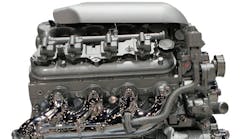Electronics distributors serving industrial markets are upbeat about business conditions in 2012, pointing to steady growth in manufacturing over the last two years and strength in key sectors such as the oil and gas, agriculture, and automotive industries early in the year.
Although business isn’t booming in every sector of the industrial economy, taken as a whole the outlook is good—especially for companies serving a wide range of end markets, says Mark Simon, vice president of sales for distributor Allied Electronics, which sells original equipment manufacturing (OEM) components as well as maintenance, repair, and operations (MRO) supplies to makers of a wide variety of capital equipment.
“Our outlook is positive when you look at it holistically,” says Simon. “The greatest strength Allied has is its diversity of clients. By segment, some are up and some are down. It’s good to have that kind of variety.”
Simon points to strength in agriculture and oil and gas exploration, in particular. He says key projects at some of the cash-rich oil companies remain underway, signaling ongoing robustness in the sector. The automotive industry rebound is another bright spot. Most of Allied’s business in the automotive sector is with ancillary markets that support the major auto manufacturers, and business has picked up quite a bit there in recent months, he says.
“The bounding back of the auto industry is \[good news\]. It’s doing quite well, so that bodes well for us,” says Simon, adding that “every time you make a model change, you retool and retest, so those ancillary businesses are doing well, too.”
Companies serving the cross-section of industrial markets often mirror the performance of the Purchasing Manager’s Index (PMI), released monthly by the Institute for Supply Management. As of early February, the PMI had remained above 50 points for 30 straight months, indicating growth in the U.S. manufacturing sector. A reading above 50 signals expansion in the sector, and a reading below 50 indicates contraction.
The PMI for January, released Feb. 1, registered 54.1, a 1% increase over December. New orders grew nearly 3%, reflecting the thirty-third straight month of growth in new orders. Production and employment in the sector grew as well, although at a slower rate compared to December.
“Manufacturing is starting out the year on a positive note, with new orders, production, and employment all growing in January,” said Bradley J. Holcomb, chairman of ISM’s Manufacturing Business Survey Committee, which conducts the PMI research, in early February.
To Simon’s point, the ISM report reflected growth in the oil and gas sector and the automotive sector in January, as the “petroleum and coal products” and “transportation equipment” categories were among nine sectors reporting growth during the month. The others were apparel, leather, and allied products; machinery; computer and electronic products; miscellaneous manufacturing (which includes medical equipment and supplies, among others); fabricated metal products; paper products; and primary metals.
The PMI data followed an increase in the December Industrial Production Index released just a few weeks earlier, in mid-January. Total industrial production rose nearly 3% in December 2011 compared to the prior-year period. Industry economists called the results an encouraging end to the year and, like Simon, pointed to ongoing strength in the automotive and oil/gas sectors.
“MAPI believes that the U.S. economy will grow at a modest 2.1% pace in 2012 and manufacturing production will increase at a faster 3.4% growth rate,” Daniel J. Meckstroth, chief economist for the Manufacturers Alliance for Productivity and Innovation (MAPI), said in mid-January. “The superior growth in manufacturing comes from pent-up demand for motor vehicles, the need to upgrade business equipment, and more investment in energy and mineral exploration.”
But again, not all sectors of the industrial economy are performing well. Simon points to a slowdown in the military sector (due to budget constraints) and a mixed bag in medical markets as two areas of concern. Looking at medical markets in particular, he says hospitals are not getting the capital they need to grow.
On the other hand, companies specializing in portable medical devices are faring better as the nation’s aging population searches for ways to avoid in-patient care and remain at home. The latter issue reflects January’s growth among makers of medical equipment and supplies reported in the ISM index.
Demand For Information Intensifies
Industrial customers are no different from other segments when it comes to the need for data, and Simon points to distributors’ efforts to increase their online capabilities as a key way of answering that call. Because so many customers have trimmed their labor forces, they need access to more information faster—and they are turning to the Web for much of it.
“The Web still leads the charge in bringing rich content \[to customers\],” explains Simon, noting that increasing Web presences and capabilities are on just about every distributor’s radar screen these days. “Customers want to make sure they can make a clear decision on what they’re buying, so they’re looking for information. \[At the same time\], getting face time with them is more precious—and harder to do.”
In either case, building strong relationships is also still at the top of the distributor agenda, Simon says. He points to Allied’s local presence across the country as a case in point.
“Having that local presence is still an important part of the relationship—and a key driver when customers are making choices about who they are going to do business with,” Simon says.








